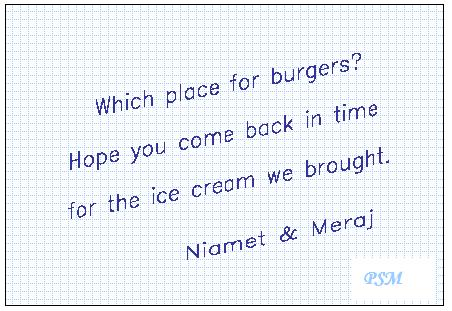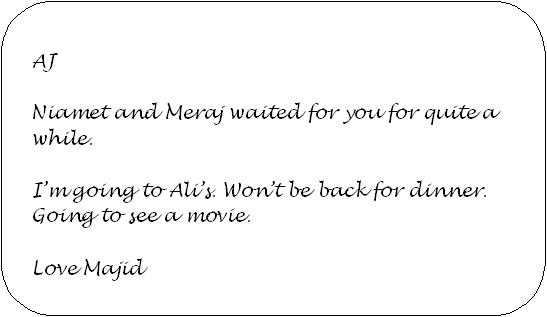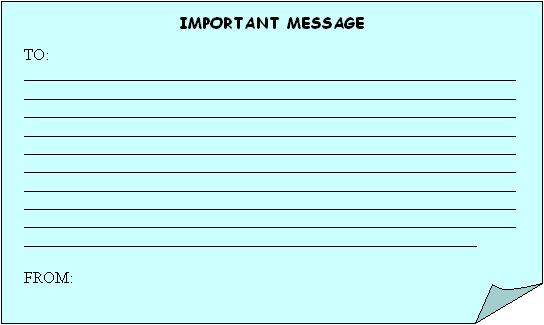MESSAGES
Azra Ahmed
Ms Azra Ahmed, a Senior Instructor at the Aga Khan University Centre of English Language, holds a Masters in the Teaching of English as a Foreign Language/an MA TEFL. She has a Diploma in Tourism Management from Kleisheim, Salzburg; a COTE (RSA) from Cambridge University, UK.; and Certificate from the Institute of Education, University of London for Online Education & Training (Language).
Introduction
A message is a very practical form of brief written communication, usually written in a hurry, and either left or sent, often by hand to someone who is absent at the time but who will probably be arriving soon. Even though messages are usually written in a hurry, they still follow certain rules of structure. One way to write more quickly is to write less - to leave some words out. Messages are often used to apologize, give instructions and/or explanations.
LESSON PLAN
Objectives:
- to give students practise in writing authentic every day material.
- to generate interest and motivation.
- to make the tasks meaningful.
- to let students have fun while learning to write.
- to give students practice in writing everyday tasks - keeping in mind their individual form, structure, tone and style.
Level: Intermediate - Advanced
Age: Adults
Time: Preferably 1 class hour for each kind of writing task, i.e. letters, messages, etc. However, the number of items per class is at the teacher's discretion.
Material: Blackboard, chalk, handouts, note and message sheets, diary paper (from old diaries), card paper and sheets of paper, pens, markers and color pencils.
Procedure
Warm-up: Can you read this message?

First you must 'break' the code, write the message on your answer sheet, and respond. Punctuate and capitalize where necessary.
Decoded Message:

TASK I
When do you leave messages? Tick (") your choice (es).
 to give someone important information to give someone important information
 to warn someone of something to warn someone of something
 to tell someone not to do something to tell someone not to do something
 to give an explanation to give an explanation
 to apologize for something to apologize for something
 to tell someone of a change of plans to tell someone of a change of plans
 to pass on details of a telephone call to pass on details of a telephone call
 other (say what you leave messages for) other (say what you leave messages for)
TASK II
Work in pairs. The four messages were written on the same day. In what order were they written? Why were they written? What do you think happened?
A.

B.

C.

D.

TASK III
Study the four messages again and complete the table below. First tick (v) each type of word that has been omitted. Then find at least one example of each type in the messages and write it in the table.
| Type of Word |
Examples |
 (to) be (to) be |
C. (I'm ) sorry the car will be a little late. |
 (to) have (to) have |
|
 other verbs other verbs |
|
 nouns nouns |
|
 pronouns pronouns |
|
 articles articles |
|
 (aux) have (aux) have |
|
 (aux) be (aux) be |
|
TASK IV
Students work in pairs.
Write an appropriate message for the following situation. Take the role of one of the characters and write accordingly.
Teacher  Student Student
Parent  Teenage Child Teenage Child
Boss  Secretary Secretary

Reference:
Boutin, M., Brindand, S., & Grellet, F. (1987). Writing: Intermediate. Oxford: Oxford University Press.
Answer Key for Lesson Plan on "Messages"
TASK I
When do you leave messages? Tick (") your choice (es).
 to give someone important information
to give someone important information
 to warn someone of something
to warn someone of something
 to tell someone not to do something
to tell someone not to do something
 to give an explanation
to give an explanation
 to apologize for something
to apologize for something
 to tell someone of a change of plans
to tell someone of a change of plans
 to pass on details of a telephone call
to pass on details of a telephone call
 other (say what you leave messages for)
other (say what you leave messages for)
We could leave messages in all instances. However most often we don't leave messages when it is something very important, only because there is a risk of it not being read. Generally explanations require details; hence it would be better to write the information in complete sentences and not phrases/disjointed sentences.
TASK II
Work in pairs. The four messages were written on the same day. In what order were they written? Why were they written? What do you think happened?
Answer: D, A, B, C
TASK III
Study the four messages again and complete the table below. First tick (v) each type of word that has been omitted. Then find at least one example of each type in the messages and write it in the table.
| Type of Word |
Examples |
(  to) be to) be |
C. I'm sorry the car will be a little late. |
 (to) have (to) have |
------------------------------------------------------------------------ |
 other verb other verb |
C. The car has still not returned/come/reached home. |
 nouns nouns |
A. Aji
B. AJ [reduced]
D. Nam [reduced]
|
 pronouns pronouns |
A. I hope you come back in time for the ice cream we brought.
B. I [have] gone for burgers.
B. I won't be back for dinner.
B. I/We am/are going to see a movie.
D. I got your message.
|
 articles articles |
C. The car still not home. |
 (aux) have (aux) have |
C. The car has still not reached home.
C. The car has still not come home.
D. I have gone for burgers.
|
 (aux) be (aux) be |
B. I/We am/are going to see a movie |

Please check the Creative Methodology for the Classroom course at Pilgrims website.
Please check the Humanising Large Classes course at Pilgrims website.
>


|